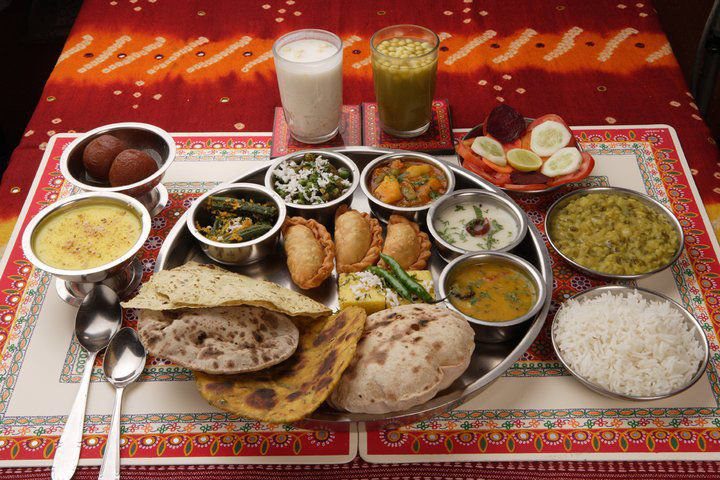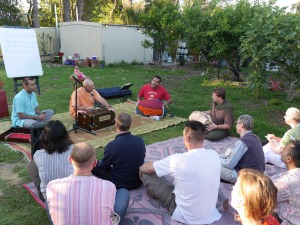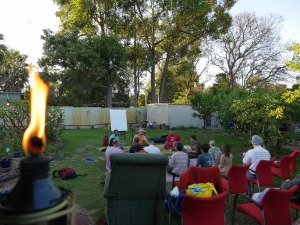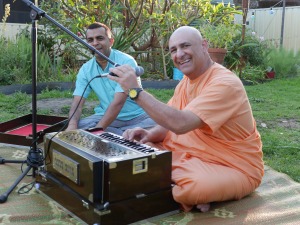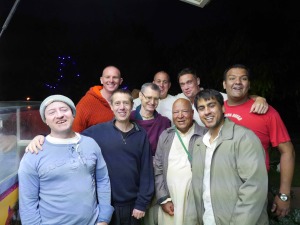Daily-bhagavatam 57 – 11.07.47 – Don’t let limitation of expression become limitation of intention
Report about the latest developments
→ SivaramaSwami.com
The post Report about the latest developments appeared first on SivaramaSwami.com.
Students visit ISKCON Delhi : 12-12-2014 (Album 18…
→ Dandavats.com

Students visit ISKCON Delhi : 12-12-2014 (Album 18 photos)
Everyday more than 500 hundred students come here to take Darshan of Sri Sri Radha Parthasarthi ji.
See them here: http://goo.gl/CbpsGf
Art of Kīrtan 4 – Example
→ The Enquirer
Here is a super basic example of the basic structure for using all three speeds of the 3-beat (half, normal and double speeds). Start off with the half speed, let it speed up and slow it back down. When you are ready, switch it to normal speed and let that consistently and gradually build speed. Then, switch it to double-speed. Let that build speed, and then break it back down to half-speed and repeat 24-hours a day.
Continued from Part 3
ISKCON One Family – Part One
→ ISKCON News
New Issue of “Imprint” Reports BBT Africa Successes
→ ISKCON News

The latest effort from the African branch of the Bhaktivedanta Book Trust – which has been publishing ISKCON Founder Srila Prabhupada’s books in various African languages since 2009 – is the e-magazine “Imprint.” The magazine, which released one issue last year but is becoming a regular quarterly with this November’s issue, is intended to communicate all the latest developments of the BBT Africa.
Bharatiyas in Egypt? (Part 2)
→ ISKCON News
New Govardhana’s contribution to the Temple of Vedic…
→ Dandavats.com

New Govardhana’s contribution to the Temple of Vedic Planetarium in Mayapur.
It seems that New Govardhana, Australia, has a special connection with the development of Temple of Vedic Planetarium (TOVP) in Mayapur, India.
Read the entire article here: http://goo.gl/H8isyc
X-mas season is the time for giving – to Radha Syama
→ SivaramaSwami.com
The post X-mas season is the time for giving – to Radha Syama appeared first on SivaramaSwami.com.
Mayapur 2015 Gaura Purnima Festival Dates Announced
→ ISKCON News

ISKCON Mayapur has announced the dates for the 2015 Gaura Purnima festival. In 2015 Gaura Purnima will be celebrated on March 5th. The Mayapur community is working very hard to accommodate the tens of thousands of devotees from all over the world that are to be expected to visit Mayapur at this time of the year.
Launching of the Srimad Bhagavatam Gifting Chain Project in Mumbai
→ ISKCON News

“The Srimad Bhagavatam Gifting Chain Project” is a unique idea inspired from the purport by Srila Prabhupada to the first verse of the first chapter of the first canto of the Srimad Bhagavatam, where Srila Prabhupada referring to the Matsya Purana, states that anyone who makes a gift of this great work on a full moon day attains to the highest perfection of life by returning to Godhead.
Indian External Affairs Minister Sushma Swaraj urges the Centre…
→ Dandavats.com

Indian External Affairs Minister Sushma Swaraj urges the Centre to declare Bhagwad Gita as national holy book.
“I am able to face the challenges as External Affairs Minister only because of the teachings of Bhagwad Gita”, Sushma Swaraj said.
Read the entire article here: http://goo.gl/P12EAp
A compilation of Govardhana silas from around the world (Album…
→ Dandavats.com

A compilation of Govardhana silas from around the world (Album 68 photos)
Srila Prabhupada: At every step there is danger. Therefore, because the Krishna consciousness movement provides the opportunity for the human being to get out of this material world simply by chanting the Hare Krishna mantra, this movement is the greatest benediction in human society. (Srimad Bhagavatam, 9.7.7 Purport)
See them here: http://goo.gl/uuz2Wx
Braja’s Life – Go-seva And Growing Your Own Food.. (Album…
→ Dandavats.com

Braja’s Life - Go-seva And Growing Your Own Food.. (Album 26 photos)
The brajabasi’s wealth are their cows or buffaloes, they store tons of hay and grow sweet 2 leaved clovers which they harvest and cut using a special hand cutting machine, ladies who don’t have land to grow grass for their cows go to distant fields and collect green grass for their cows. And their is no end to their seasonal vegetable gardens, all fresh and GMO free. Hare Krishna!
See them here: http://goo.gl/ZgLPYn
Nature Is Speaking – Penélope Cruz is Water
→ ISKCON News
Go Puja at Hare Krishna Valley, Melbourne (6 min video)
Srila…
→ Dandavats.com

Go Puja at Hare Krishna Valley, Melbourne (6 min video)
Srila Prabhupada: The Hare Krishna chant is called the maha-mantra, the great, exalted mantra above all other Vedic mantras, because simply chanting the Hare Krishna maha-mantra brings so many beneficial effects. (Srimad Bhagavatam, 9.1.17 Purport).
http://goo.gl/z1TiKO
Sushma Swaraj Urges Centre to Declare Bhagavad Gita as National Holy Book
→ ISKCON News
UN to Declare June 21 As World Yoga Day: Sushma Swaraj
→ ISKCON News
Gita 02.23 – The utter indestrutibility of the soul underlies the path of difficult duty
→ The Spiritual Scientist
Gita verse-by-verse study Podcast:
Mangala Aratik Iskcon London 20141204043048
→ Gouranga TV - The Hare Krishna video collection
Mangala Aratik Iskcon London 20141204043048
Gita 10.01 – The tirelessly loving Lord mercifully manifests as the easily accessible holy name
→ The Spiritual Scientist
Gita 01.40 – Protecting women and ensuring good progeny are important social responsibilities
→ The Spiritual Scientist
Gita verse-by-verse study podcast:
Gita 08.06 – Change your contempation during meditation to change your destination after destruction
→ The Spiritual Scientist
Holy Name Meditation Podcast:
The More We Distribute, The More We Get, December 1, New Dwaraka, Los Angeles
Giriraj Swami
 The members of the Krsna consciousness movement are not at all interested in so-called meditation in the Himalayas or the forest, where one will only make a show of meditation, nor are they interested in opening many schools for yoga and meditation in the cities. Rather, every member of the Krsna consciousness movement is interested in going door to door to try to convince people about the teachings of Bhagavad-gita As It Is, the teachings of Lord Caitanya. That is the purpose of the Hare Krsna movement. The members of the Krsna consciousness movement must be fully convinced that without Krsna one cannot be happy. Thus the Krsna conscious person avoids all kinds of pseudo spiritualists, transcendentalists, meditators, monists, philosophers and philanthropists.
The members of the Krsna consciousness movement are not at all interested in so-called meditation in the Himalayas or the forest, where one will only make a show of meditation, nor are they interested in opening many schools for yoga and meditation in the cities. Rather, every member of the Krsna consciousness movement is interested in going door to door to try to convince people about the teachings of Bhagavad-gita As It Is, the teachings of Lord Caitanya. That is the purpose of the Hare Krsna movement. The members of the Krsna consciousness movement must be fully convinced that without Krsna one cannot be happy. Thus the Krsna conscious person avoids all kinds of pseudo spiritualists, transcendentalists, meditators, monists, philosophers and philanthropists.
—SB 7.9.44 purport
Gita 02.22 – The dress metaphor redefines death not as a miserable termination but as a welcome transition
→ The Spiritual Scientist
Gita 02.21 – Integrate knowledge of the soul with the purpose of that knowledge
→ The Spiritual Scientist
HG Narottamananda Prabhu / SB 10.73.18-20
→ Kalachandji's Audio Archive
Gita 02.20 – The soul doesn’t undergo the six changes that matter does
→ The Spiritual Scientist
In SB 1.2.7 if the knowledge is acquired through devotion how is it causeless?
→ The Spiritual Scientist
Answer Podcast:
Please Join The Japa Group
→ Japa Group
Bhakta Santa is coming to town on Dec 25th
→ ISKCON Brampton

Greatest benediction!
→ Servant of the Servant
At every step there is danger. Therefore, because The Krishna Consciousness Movement provides the opportunity for the human being to get out of this material world, simply by chanting the Hare Krishna Mantra, this movement is the greatest benediction in the human society.
- Srimad Bhagavatam, 9.7.7 purport
Chant for purification
→ KKSBlog
(Kadamba Kanana Swami, October 2014, Mayapur, India, Siksastakam Seminar: Verses 1&2, Part 1)
 Currently, our chanting may not be so complete, in the sense that it is free from any form of anartha or aparadha, and done in a full transcendental knowledge. But all chanting will help in purifying the dust from the heart to different degrees. Ceto-darpana-marjanam (Siksastakam 1). We begin our chanting as a process of purification. Therefore, our first motive in chanting is for purification and this should be our approach: we do everything for purification.
Currently, our chanting may not be so complete, in the sense that it is free from any form of anartha or aparadha, and done in a full transcendental knowledge. But all chanting will help in purifying the dust from the heart to different degrees. Ceto-darpana-marjanam (Siksastakam 1). We begin our chanting as a process of purification. Therefore, our first motive in chanting is for purification and this should be our approach: we do everything for purification.
Someone said to me, ‘I have no taste for chanting, so I gave up chanting. I cannot do it anymore – I have done it for years and I just had no taste for it and therefore I just can’t do it anymore!’ So what do you say to someone like that, especially after they have chanted for many, many years? I was thinking of what to say and after some thinking I said, ‘Look, for you it is too late, as you have chanted for too long! You are a devotee and there is nothing you can do about it; whether you chant or not, you are going to be a devotee. But there are two options for you: either you are going to be a happy devotee or you are going to be an unhappy devotee. And if you don’t chant you are going to be an unhappy devotee. But if you chant you can be a happy devotee!’
So we chant for purification; it is not about, ‘I have no taste!’ So much talk is there about taste, a higher taste, and that is good because we want to get there, to chant with a higher taste, but at the same time, chanting with a higher taste is quite high. Maybe sometimes we are chanting with some higher taste but to chant with a higher taste all the time is high. Therefore, for most of us, we go back to that platform of looking for purification, again and again, that should be there – looking for mercy and purification. Look for more purification and if anything more comes – some moments of higher taste – that is a bonus, that is extra, but that is not what should drive us, ‘Oh, I am chanting and still no higher taste!’
Maybe not, maybe not in this life, maybe the next life! Maybe not in the next life, but maybe the life after that, or maybe after a hundred lives, the higher taste will come. So, chant for purification because the mercy is so great, the gift that comes is so great, that is worthy of all efforts.
Texas Faith 136: A cup of coffee and other holy rituals
→ Nityananda Chandra Das' Blog, ISKCON Dallas
 Dallas Morning News,
Dallas Morning News,
Each week we will post a question to a panel of about two dozen clergy, laity and theologians, all of whom are based in Texas or are from Texas. They will chime in with their responses to the question of the week. And you, readers, will be able to respond to their answers through the comment box.
Every faith has its rituals. Hopefully these help put us in the mind of being with God and make us more present in our prayer.
Our lives have their little rituals too.
In a recent article,Rabbi Patrick “Aleph” Beaulier wrote about the ritual of a morning cup of coffee.
The coffee is a pleasure certainly, but it is also a moment set aside, at best, for a little peace, perhaps silence and reflection. These moments apart are important to our lives as people of faith, as people who are trying to draw ourselves nearer to God. We have our rituals in our religious ceremonies too, often freighted or filled with symbolism and intended, in their own way, to draw us away from the run of our thoughts and into the peace we hope faith will bring.
How can our little daily rituals bring us closer to God? How can we make sure that, in everyday moments, we are building our path to the divine?
NITYANANDA CHANDRA DAS, minister of ISKCON (International Society for Krishna Consciousness), Dallas
In the Bhagavad Gita Śrī Krishna states in the ninth chapter that the art of doing everything for His sake is the perfection of yoga. In fact this is the perfection of life. To be 24 hours a day engaged in consciousness of Krishna, God. Our daily habits play a huge role to cultivate this consciousness. Upon waking a bhakta first chants the Lord’s holy names and bows with his head down before even leaving the bed. Followed by an early morning shower to not only keep the body clean but to refresh one’s consciousness. Kirtan and prayers begin at the temple at 4:30 am followed by a 2 hour session of meditation. Then again there is kirtan at 7 am followed by a class on the ancient Śrīmad Bhāgavatam. The bhakta follows a similar program in the evening as well, creating a sandwich of transcendental experiences.To see all responses of the TEXAS Faith panel click here.
Speaking of sandwiches this brings up another related topic. Everyone has to eat but food is not simply something for the belly, food is often a practical means to express love. Who better to love than the supreme loveable, Krishna? God is the root of everything, by watering the root all the leaves can be satisfied. Therefore the bhakta does not eat any food that cannot be first offered to God with love. Thus they abstain from eating animals. So not the act of eating can be a spiritual engagement but even the shopping, the cooking, and prep work as well. This is the art of Bhakti, to learn the ancient and blissful science of doing everything in the service of God.
4 Minute Krishna Podcast @ BKS Iyengar Yoga – Wine VS Yoga
→ Nityananda Chandra Das' Blog, ISKCON Dallas
Texas Faith 135: When is a city ban on feeding the poor an infringement on religious liberty?
→ Nityananda Chandra Das' Blog, ISKCON Dallas
 Dallas Morning News,
Dallas Morning News,
Each week we will post a question to a panel of about two dozen clergy, laity and theologians, all of whom are based in Texas or are from Texas. They will chime in with their responses to the question of the week. And you, readers, will be able to respond to their answers through the comment box.
When is a city ban on feeding the homeless in a public place an infringement on religious freedom?
In Florida, a 90-year-old WWII veteran was arrested for feeding the homeless at a public park. He’s been doing it for over 20 years through a program called Love Thy Neighbor. But a new ordinance in Fort Lauderdale has put a mountain of obstacles in the way, making it virtually impossible for the group to operate as it has.
(Joe Raedle/Getty Images)
On one side are local businesses that fear feeding the homeless in a conspicuous place was bad for business and tourism. On the other side are advocates of Love Thy Neighbor who say the group is within its constitutional rights. The city tried to balance the interests of both sides with rules aimed at moving such homeless programs into houses of worship or private property. But the organization wants to continue feeding the homeless as it has, in a seaside public park.
The clash between religious rights and the public interest is a common story line. We’ve weighed in on the dustup in Houston in which the city tried to subpoena the sermons of evangelical ministers opposed to a gay-rights ordinance. And every week, it seems, there’s a new report in which the advocates of religious liberty decry a rule or action at a public school.
Religious liberty isn’t absolute. There’s no right to hold a serpent-handling service at Disneyland. Or to shout “fire” in a crowded church because your religion told you to. Or to build a megachurch in a city neighborhood with a parking lot for only 10 cars.
In the case of feeding the homeless in Fort Lauderdale, the name of the organization is from a biblical injunction. Its mission is an act of faith. And if some businesses are inconvenienced or tourists would prefer not having to see the homeless by the beach, whose rights should prevail?
That’s this week’s question: Is a city ban on feeding the homeless in a public place an infringement on religious freedom?
NITYANANDA CHANDRA DAS, minister of ISKCON (International Society for Krishna Consciousness), Dallas
Every body needs a head. So similarly, every society needs saintly intellectuals for guidance. Leadership without such guidance is like a body without a head. Leadership is like the arms of the social body which provides protection and business class is like the belly which facilitates the distribution of goods. All parts of the body are important but the head is the most important for it is the head of body that provides intelligence.
Intelligence means the ability to accommodate and manage two opposing values. It also means the ability to discriminate that which is śreyas, of long term substantial benefit, and preyas, immediate or short term gratification. The short term benefit of commerce is important but it is considered shallow in comparison to charity which can have long lasting or even eternal benefits.
Krishna states that charity, when done properly, even purifies great souls. To completely ban charitable distribution of food in relation to the value of commerce is sign of the lack of saintly intelligent guidance among our leaders.
To see all responses of the TEXAS Faith panel click here.
Program in Gardens
→ Ramai Swami
The Baywater Council allowed Devaprastha das to cultivate non-residential land near his house into an orchard and vegetable garden. Produce is available free to the local community.
TEXAS FAITH 134: How should we incorporate faith into a secular political world?
→ Nityananda Chandra Das' Blog, ISKCON Dallas
 Dallas Morning News,
Dallas Morning News,
Each week we will post a question to a panel of about two dozen clergy, laity and theologians, all of whom are based in Texas or are from Texas. They will chime in with their responses to the question of the week. And you, readers, will be able to respond to their answers through the comment box.
 The writer Karen Armstrong recently noted that it was through bitter experience the west learned to separate the state from religion and wonders why Muslims have "found it impossible to arrive at this logical solution to their current problems."
The writer Karen Armstrong recently noted that it was through bitter experience the west learned to separate the state from religion and wonders why Muslims have "found it impossible to arrive at this logical solution to their current problems."
The mature fruit of the concept of separation of church and state is realized when the leadership guides by being God-conscious examples. The original intention of the concept was not to deny or ignore God, but rather to inhibit the government from forcing a particular sectarian religion. However our founder fathers have put forward this propaganda, "In God We Trust." In governmental decisions one is forced to deal with metaphysical subjects, such as rights. A human, an embryo, nor an animal's right to life cannot be established by mere science. It is therefore necessary to approach the such subjects with metaphysical wisdom and mercy from God.
To see all responses of the TEXAS Faith panel click here.
Bhagavatam-daily 56 – 11.07.46 – Take shelter of Krishna however that manifests to us
→ The Spiritual Scientist
Callous Nurse?
→ simple thoughts
Reading the social media it is always interesting the many different activities devotees get up to including realisation and personal thought’s.
This week it was sad to hear of a devotee who collapsed and had to be airlifted to hospital, thankfully this happened on a Sunday so the observer noted how quickly the doctors immediately moved from devotional to professional resuscitation mode. Bhaktivadanta Manor is blessed by many amazing doctors who care for the devotees and to have three working on you is truly a blessing; and as the devotee was flown to the nearest specialist heart unit the devotees immediately returned to their activities if not more aware of how frail the material body is.
One reader noted that they felt that this was a little callous an interesting choice of words as the Oxford online dictionary definition is:
Showing or having an insensitive and cruel disregard for others:
his callous comments about the murder made me shiver
Would we describe nurses and those in the medical profession as callous?
Having worked in the front line and being part of a resuscitation team I can say that in all cases I’ve returned to what I was doing before the crash bleep went off or simply gone to my car and headed home or gone for a meal out. Little thought on the life lost of saved its simply part of the job.
Most students when faced with this reality of nursing either leave the profession as its too much to cope with or learn quickly how to switch off in other words absorbe oneself in the next nursing task or ones own personal life; so I could say if looking from the outside it does appear to be callous.
It reminded me of a devotee who thought that as I work in health care then this gives me an exception insight into the cycle of life and its limitations and shortness; they were a little surprised by my answer “You would think so but in reality NO! I’m too busy working to really give it a thought” they looked startled.
What it has highlighted to me as my knowledge in Krishna Consciousness slowly grows is how cunning Maya is and how quickly we are covered by the reality’s of material life, within a short time of even seeing the human suffering as I change out of the nurse uniform and into my civil clothes Maya has covered me in absorption in my own thoughts and life.
If it wasn’t for this covering I’m sure all our centres would be full of nursing and medical staff looking at and trying to understand why their is so much suffering, but Maya is so good that within a short time forgot.
So in many ways their is indeed a callous part within what is perceived as a very caring mode of goodness profession.
Contrasting this with the devotees yes meetings and the temple programme had to continue Bhaktivadanta Manor especially on Sunday is a busy vibrant place indeed, but those who observed not only personally reflected but alerted those on social media so we can offer prays for this special soul this it true compassion.
It also reminded me of one of my first conversations with my now beloved Guru Maharaja who questioned me on nursing you look after the body but What About The SOUL? True compassion is when whilst caring for the body you also care for the spirit soul so they can return home. Which means that even if it appears that the usual activities of life resumes pray is offered, they remain in our thoughts.
And so the external appearance does not show the internal compassion, it does remind me though how powerful Maya is and how my own personal actions should be absorbed in devotional activities and carrying out my guru maharaja instructions as time in this particular material body is short so best use it in a productive manor.
As for the devotee I believe they are in intensive care so let’s remember them in our prays.





